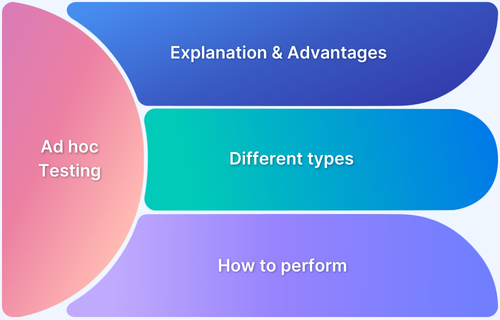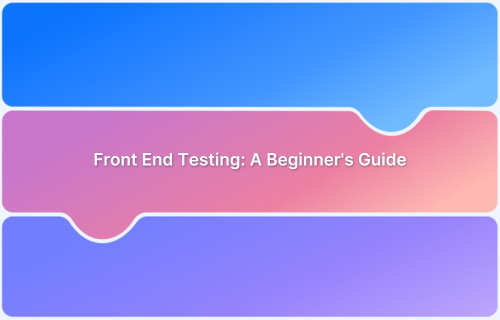In exploratory testing, testers do not work based on previously created test cases. They check a system without a plan to discover bugs that users may face when navigating a website or app without a specific aim or direction.
What is Exploratory Testing?
Exploratory Testing is an approach where testers actively explore the software to identify issues and assess user experience without relying on predefined test cases.
This method emphasizes spontaneous exploration and personal decision-making, allowing testers to navigate the application as real users would. By focusing on discovery and investigation, exploratory testing often uncovers issues and edge cases that traditional testing might overlook, offering deeper insights into the software’s quality and usability.
Importance of Exploratory Testing
Exploratory testing plays a crucial role in CI/CD by adapting to rapid development cycles and uncovering hidden issues that automated tests might miss.
It enhances software quality through continuous improvement, user-centric testing, and creative problem-solving.
Why Exploratory Testing is Essential for CI/CD:
- Adaptive Testing: Aligns with fast-paced CI/CD workflows by adjusting focus based on evolving requirements.
- Encourages Innovation: Uncovers unique issues through creative testing approaches.
- Continuous Improvement: Regular testing refines software quality and performance.
- Enhanced Collaboration: Involves testers early, improving coordination between development and QA teams.
- Expands Test Coverage: Identifies defects in areas not covered by automated tests.
- User-Centric Testing: Evaluates applications from an end-user’s perspective for better usability.
- Quick Issue Detection: Helps identify bugs early in the development cycle, reducing costly fixes later.
- Ideal for Agile Teams: Supports rapid iteration and flexible testing in dynamic environments.
Learn More: Adhoc Testing vs Exploratory Testing
Types of Exploratory Testing
Exploratory testing can be categorized into different types based on the approach and objective. Below are the key types:
- Freestyle Exploratory Testing: A completely unstructured approach where testers explore the application without predefined guidelines. It is mainly used for quick verifications, investigating defects, or performing smoke tests.
- Scenario-based Exploratory Testing: Focuses on real user scenarios, where testers simulate different use cases to identify potential issues and maximize test coverage.
- Strategy-based Exploratory Testing: Conducted by experienced testers using specific testing techniques such as boundary value analysis, equivalence partitioning, and risk-based testing to uncover complex bugs.
Must Read: Sanity Testing vs Smoke Testing
When to use Exploratory Testing?
Exploratory Testing is ideal in the below scenarios:
- When Time is Limited: Use exploratory testing in time-constrained projects where there isn’t enough time to create comprehensive test scripts, allowing testers to quickly identify critical issues.
- During Early Development Stages: Apply exploratory testing in early development phases to uncover initial bugs and gather feedback before detailed test cases are created.
- For Complex or Unfamiliar Systems: Use it when dealing with complex or new applications where predefined tests may not cover all scenarios, leveraging testers’ creativity to explore unknowns.
- To Complement Automated Testing: Combine exploratory testing with automated tests to cover scenarios not addressed by automated scripts, enhancing overall test coverage.
- When Adapting to Rapid Changes: Implement exploratory testing when features are frequently updated or changed, as it allows testers to adjust focus based on the latest developments.
- To Assess User Experience: Utilize exploratory testing to evaluate how real users interact with the application, identifying usability issues and ensuring a smooth user experience.
When not to use Exploratory Testing?
Exploratory Testing is not ideal in the below scenarios:
- When Detailed Test Coverage is Required: Avoid exploratory testing when comprehensive, repeatable test coverage is necessary, such as for compliance or regulatory requirements that demand structured testing.
- For Highly Repetitive Tasks: If the testing involves repetitive, well-defined tasks that are best addressed through automated scripts, exploratory testing may not be as effective.
- In the Absence of Testable Software: When the software is incomplete or unstable, making it difficult to perform meaningful exploration, it’s better to wait until the product is more stable.
- When Clear Objectives are Needed: If the goal is to validate specific functionalities or features against detailed requirements, structured test cases might be more appropriate.
- For Large-Scale Systems with Complex Dependencies: In systems with numerous dependencies and complex interactions, exploratory testing might not provide the thorough coverage needed, making structured approaches preferable.
- When Testing Resources are Limited: If the testing team lacks the experience or familiarity with the application, exploratory testing might be less effective than using predefined test cases.
Exploratory Testing Example
For example, developers of a shopping website know what it is meant to do. Let users select products of their choice, move them to the cart, pay, and confirm their order. The team would approach the testing more freely, without a rigid plan in exploratory testing.
Exploratory testing helps verify that the system works as expected and is an easy and pleasant user process. It lets testers ensure that extra features (payment through rewards points, ordering products for trial purposes) work flawlessly. They would try to break the elements/features by testing the boundaries with unexpected scenarios. This way, QA can find bugs that was not part of the test case and work around to fix it.
Exploratory Testing Process
Here are the steps involved in the Exploratory Testing Process:
Step 1. Classify the Bugs
- Categorize the commonly detected bugs in similar software. Use Bug Severity and Bug Priority for categorization.
- Analyze and record the root cause of such bugs.
Pro Tip: Use real devices for testing to consider real user conditions. These might seem trivial, and tests might pass in Emulators, but it impacts the overall user experience in the real world.
- Create test scenarios to test for these bugs.
Step 2. Create a Test Charter
The Test Charter should include:
- What features to test?
- How to test it? Create a comprehensive Test Plan.
- What bugs to look for? Such as Visual Bugs, Functionality Bugs, etc.
- What Agile Testing Metrics to keep in mind while testing?
Step 3. Time Box
The point of the Time Box is for testers to test and respond to system responses. It involves the following steps in a particular slot.
- Testers work on the tests outlined above for a specific time (usually 90 minutes).
- This time should be without interruptions.
- The timebox can be extended or reduced (depending on test progression).
Step 4. Review Results
- Catalog the identified bugs using effective defect management.
- Evaluate the defects.
- Note down the learnings in a bug report.
Step 5. Debriefing
- Compile the output results.
- Compare actual results with expected results in the test charter.
- Decide whether additional testing is required using a test summary report.
Do you know how to write a good test summary report? Learn Now!
Exploratory Testing Tools
- Test automation tools: Although exploratory testing is primarily a manual process, test automation tools can help automate repetitive or time-consuming tasks, freeing up testers to focus on more experimental work. For example, automated regression tests can be run in the background while testers focus on exploratory testing. Some popular test automation tools include Selenium, Appium, and TestComplete.
- Debugging tools: Debugging tools can help testers identify and isolate defects more quickly and effectively during exploratory testing.
- Recording and playback: These tools allow testers to record actions or interactions with an application and then play them back to replicate the same behavior. This can be useful for automated regression testing or for creating reproducible test cases.
Top Exploratory Testing Tools
Here is a list of the top 12 exploratory testing tools:
- BrowserStack: A cloud-based cross-browser testing platform for testing websites and apps on various devices and browsers in real-time.
- Bug Magnet: A browser extension that provides context-aware input suggestions for edge case testing, like boundary values, special characters, and invalid inputs.
- Testpad: A lightweight, checklist-style test management tool focused on simplicity and flexibility for exploratory and manual testing.
- Test IO: A crowd testing platform that connects you with professional testers worldwide to perform exploratory testing on your software.
- Exploratory Testing Chrome Extension: A simple Chrome extension designed to log exploratory testing sessions, including notes, screenshots, and session details.
- SpiraCapture: A session-based exploratory testing tool that captures user interactions, notes, and screenshots for seamless bug reporting and documentation.
- Telerik Fiddler: A web debugging proxy tool used for capturing HTTP/HTTPS traffic, which can help analyze and troubleshoot application behavior during testing.
- Testiny: A modern test management tool that supports exploratory testing with simple test planning, execution, and reporting features.
- Testuff: A test management platform offering video recording of test sessions, aiding exploratory and manual testing with better defect reporting.
- Rainforest: A no-code testing platform that provides on-demand exploratory testing services using both automated and human testers.
- Rapid Reporter: A lightweight session-based testing tool for taking quick notes during exploratory testing sessions and generating session reports.
- Session Tester: An open-source exploratory testing tool that allows you to create, manage, and document exploratory testing sessions effectively.
Follow-Up Read: Test Automation Tool Evaluation Checklist
Advantages of Exploratory Testing in Agile Development
Exploratory testing is highly beneficial, particularly in fast-paced development environments like Agile. Below are its key advantages:
- Encourages Rapid Feedback: Provides immediate insights into software performance and usability, speeding up the feedback loop.
- Uncovers a Wide Range of Bugs: Helps identify functional, integration, and usability issues that may go unnoticed in scripted testing.
- Enhances Problem-Solving Skills: Allows testers to develop critical thinking and gain a deeper understanding of the application.
- Adaptable to Agile Development: Fits well in Agile cycles where requirements evolve frequently, ensuring continuous and flexible testing.
- Requires No Predefined Scripts: Can be performed by developers, testers, designers, or stakeholders without the need for detailed test cases.
- Ideal for Iterative Development: Supports rapid testing of new features while automated tests focus on regression and backward compatibility.
- Effective for Unstable Requirements: Works well in projects with changing requirements, delivering quick and actionable testing results.
Read More: The Complete Guide to Ad hoc Testing
Disadvantages of Exploratory Testing
While exploratory testing offers flexibility and rapid feedback, it also comes with certain challenges:
- Lack of Documentation: Since testing is unscripted, tracking what has been tested can be difficult, making issue replication challenging.
- Inconsistent Test Coverage: Without predefined test cases, ensuring comprehensive coverage of all functionalities can be difficult.
- Tester Dependency: The effectiveness of exploratory testing depends heavily on the tester’s skills, experience, and domain knowledge.
- Limited Repeatability: Since the test approach is not predefined, reproducing exact test conditions for future reference or debugging can be challenging.
- Not Ideal for Large-Scale Testing: Exploratory testing alone may not be sufficient for extensive applications requiring structured validation.
- Difficult to Measure Effectiveness: Unlike scripted testing, there are no predefined metrics, making it harder to quantify results.
- Not Suitable for Compliance Testing: Regulatory or compliance-driven industries often require strict documentation, which exploratory testing lacks.
Best Practices for Exploratory Testing
By following best practices, testers can maximize the effectiveness of exploratory testing, ensuring thorough test coverage and improved software quality.
- Ensure Clear Test Objectives: Define a clear mission for each exploratory testing session to maintain focus.
- Break Down the Software: Divide the application into modules to improve test coverage and make the process manageable.
- Use a Feature Checklist: Maintain a list of features to be tested to prevent omissions.
- Start with Basic Scenarios: Begin testing with fundamental user journeys before expanding to complex interactions.
- Validate UI/UX Standards: Check the GUI against design guidelines and usability principles.
- Maintain Detailed Records: Document test findings, including defects, unusual behaviors, and observations.
- Test with Real Devices & Browsers: Use real environments rather than emulators to replicate real user experiences.
- Analyze Competitor Issues: Stud y common issues in competitor applications to anticipate potential problems.
- Leverage User Feedback: Continuously incorporate real user feedback into exploratory test strategies.
- Adapt & Evolve Testing Strategies: Remain flexible and adjust testing approaches based on findings and software updates.
Conclusion
Exploratory testing empowers testers to think creatively, discover edge cases, and identify critical defects that might otherwise go unnoticed. By selecting the right exploratory testing tools and incorporating real device testing into your workflow, you can elevate your testing processes to new heights.
Platforms like BrowserStack simplify and enhance exploratory testing with powerful solutions like Live and App Live, enabling testers to test on real devices across a wide range of browsers and operating systems. With BrowserStack, teams can quickly identify and address issues that impact the user experience, ensuring their applications meet the highest quality standards.





